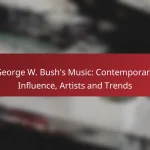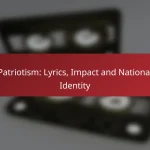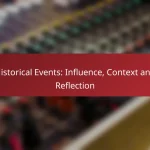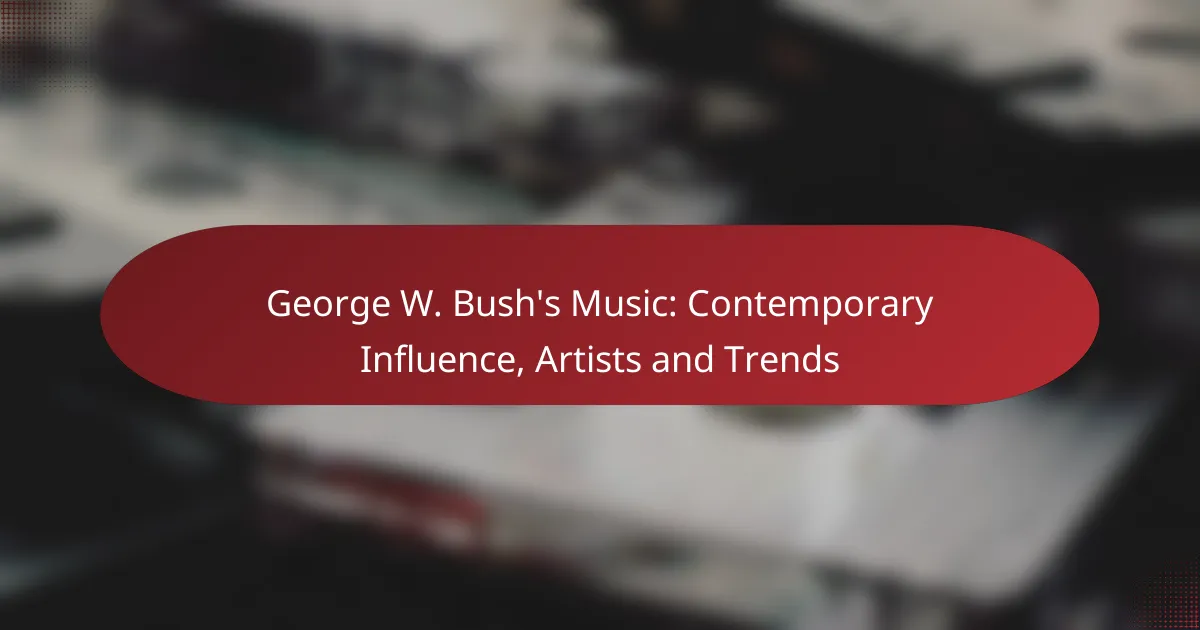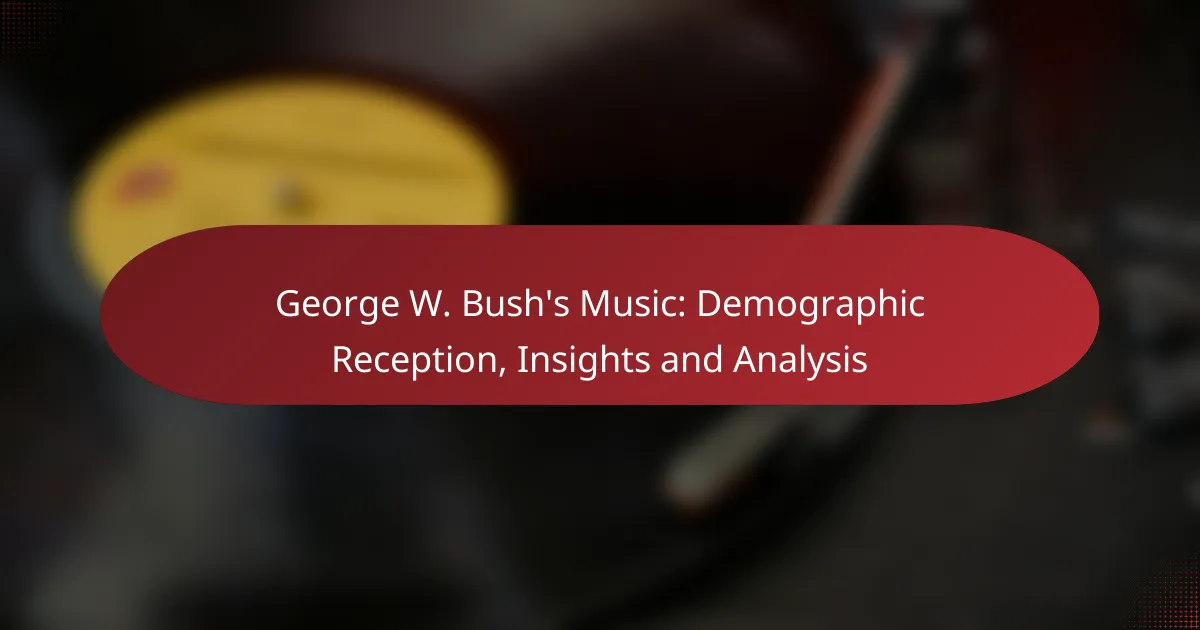George W. Bush’s presidency left a lasting mark on American music culture, particularly through his endorsement of country music and patriotic anthems. His administration coincided with a revival of these genres, which not only mirrored the national mood but also influenced the musical landscape of the early 21st century. By intertwining music with political identity, Bush shaped public perceptions and set a new standard for the relationship between politics and music.

How did George W. Bush influence American music culture?
George W. Bush significantly influenced American music culture through his promotion of country music, support for patriotic songs, and impact on music festivals. His presidency coincided with a resurgence of these genres, reflecting national sentiments and shaping the musical landscape of the early 21st century.
Promotion of country music
During Bush’s presidency, country music gained immense popularity, often reflecting themes of patriotism and American values. Artists like Toby Keith and Alan Jackson became prominent figures, with their songs resonating with the public’s sentiments during and after events like 9/11.
The Bush administration’s visibility at country music events helped elevate the genre’s status in mainstream culture. This promotion not only supported established artists but also opened doors for emerging country musicians, contributing to a vibrant music scene.
Support for patriotic songs
Bush’s tenure saw a rise in patriotic songs that celebrated American ideals and resilience. Songs like “Courtesy of the Red, White and Blue” by Toby Keith became anthems of national pride, often played at public events and military gatherings.
This support for patriotic music fostered a sense of unity and collective identity among Americans, especially in times of crisis. The emphasis on such songs encouraged artists to create music that reflected national pride, further embedding these themes into the fabric of American music culture.
Impact on music festivals
Music festivals during Bush’s presidency began to incorporate more country and patriotic themes, attracting diverse audiences. Events like the Country Music Association Festival saw increased attendance, highlighting the genre’s growing influence.
Additionally, festivals often featured performances by artists known for their patriotic songs, creating a celebratory atmosphere that resonated with attendees. This shift not only boosted the popularity of country music but also reinforced its role in American cultural identity during that era.
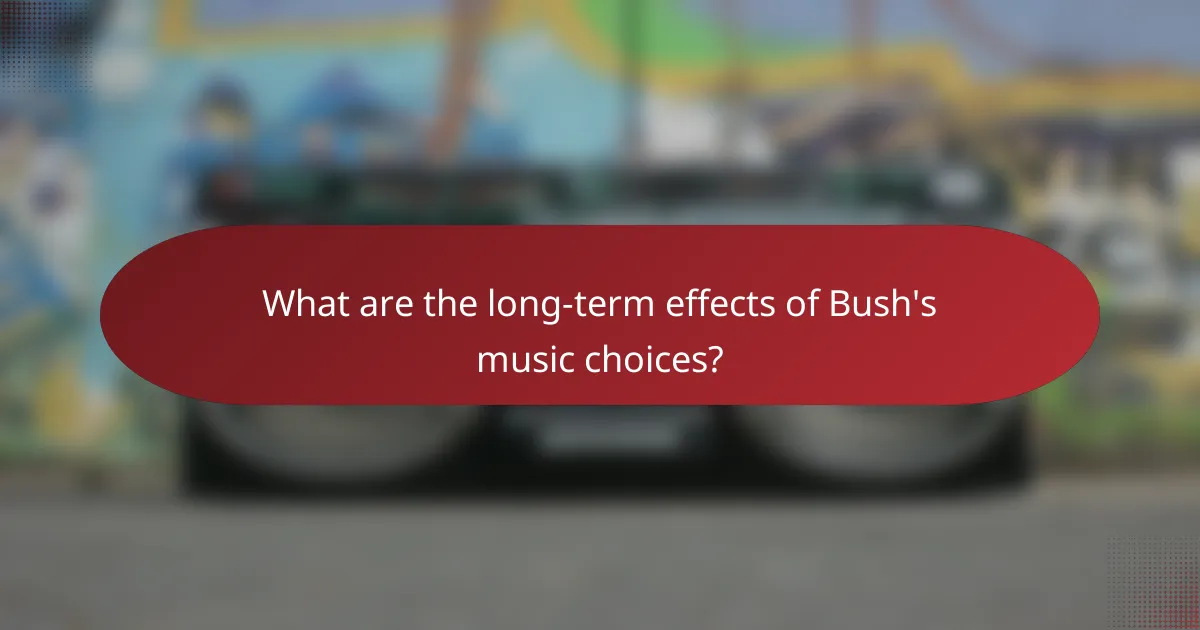
What are the long-term effects of Bush’s music choices?
George W. Bush’s music choices have influenced the political landscape by shaping public perceptions and expectations of political figures. His selections often reflected a blend of traditional American values and contemporary trends, which resonated with various demographics and set a precedent for future political music integration.
Shift in political music themes
During Bush’s presidency, there was a noticeable shift in political music themes, moving towards a more patriotic and optimistic tone. Artists began to align their music with national pride, often incorporating themes of unity and resilience in response to events like 9/11. This shift encouraged musicians to engage more directly with political narratives, impacting how music was used in campaigns.
As a result, songs that previously focused on critique or protest began to embrace a celebratory approach, reflecting a desire to uplift the national spirit. This evolution has continued, influencing how contemporary artists approach political themes in their work.
Increased commercialization of music
Bush’s era marked a rise in the commercialization of music within the political sphere, as campaigns recognized the potential of music to sway public opinion. Political parties began to leverage popular songs to enhance their branding, leading to strategic partnerships with artists and labels. This trend blurred the lines between artistic expression and commercial interests.
As music became a tool for political messaging, the focus shifted towards creating catchy, marketable anthems that could easily resonate with voters. This commercialization has led to debates about authenticity in music and its role in political discourse.
Legacy of music in political campaigns
The legacy of Bush’s music choices is evident in how modern political campaigns utilize music to connect with voters. Campaigns now often curate playlists that reflect their values and target demographics, recognizing the emotional power of music. This practice has become a standard strategy, with candidates using music to create memorable moments during rallies and events.
Moreover, the integration of music into political campaigns has raised questions about the relationship between artists and politicians. While some artists embrace the collaboration, others are cautious about being associated with political agendas, leading to a complex dynamic in the music industry.

How did Bush’s presidency affect music genres?
George W. Bush’s presidency had a significant impact on various music genres, particularly country, rock, and pop. The political climate and cultural events during his time in office shaped the themes and styles of music, influencing artists and listeners alike.
Rise of country music popularity
During Bush’s presidency, country music saw a notable surge in popularity, often reflecting patriotic themes and sentiments. Artists like Toby Keith and Alan Jackson gained prominence, with songs that resonated with the American public’s feelings during events such as the September 11 attacks and the Iraq War.
This era also marked a shift in country music’s mainstream appeal, as it began to incorporate elements from pop and rock, attracting a broader audience. The genre’s connection to American identity and values became more pronounced, with many songs celebrating themes of resilience and patriotism.
Influence on rock and pop artists
Rock and pop artists responded to the political landscape of the Bush era with a wave of protest music and critical commentary. Bands like Green Day and Rage Against the Machine produced works that challenged government policies and highlighted social issues, reflecting a growing discontent among younger audiences.
Additionally, the blending of genres became more common, with pop artists incorporating rock elements to address political themes. This cross-pollination not only diversified the music scene but also encouraged artists to engage with the socio-political climate, resulting in a rich tapestry of sounds and messages during this period.
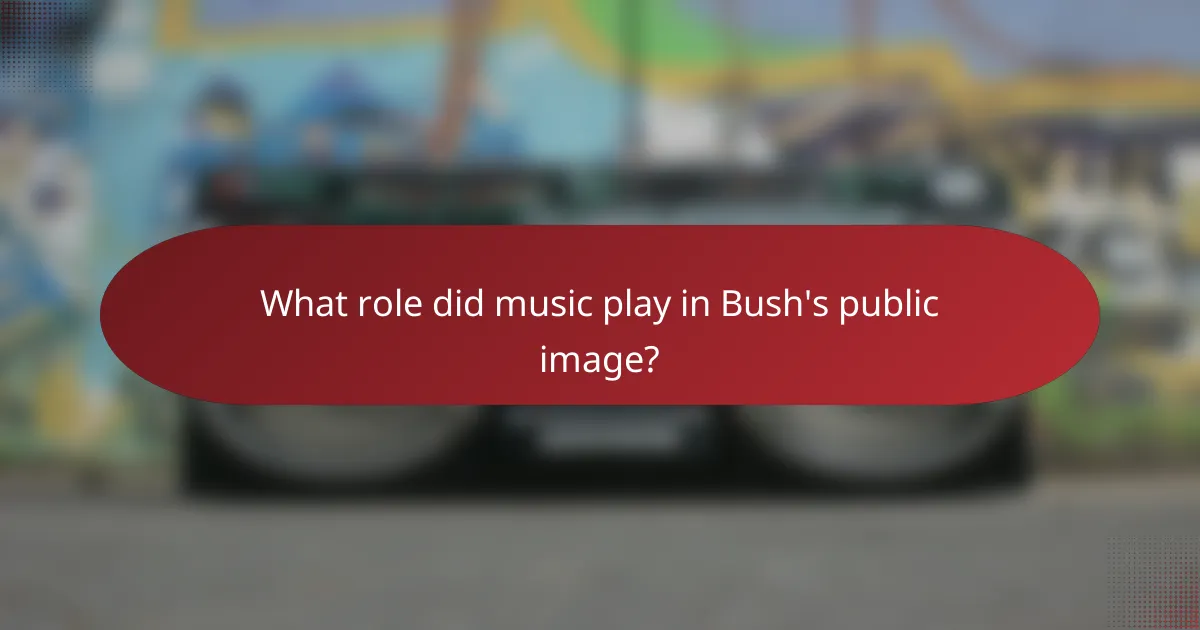
What role did music play in Bush’s public image?
Music significantly shaped George W. Bush’s public image by reinforcing his messages and connecting with audiences. His strategic use of music helped to convey emotions, create a sense of unity, and enhance the overall impact of his speeches and public appearances.
Use of music in speeches
George W. Bush often incorporated music into his speeches to evoke specific emotions and set the tone for his messages. For instance, he would play patriotic songs during key addresses, especially around national holidays or significant events, to inspire feelings of pride and solidarity among listeners.
Additionally, the choice of music often reflected the themes of his speeches. Songs like “God Bless the USA” and “Born in the USA” were used to resonate with American values, reinforcing his connection with the audience and enhancing the emotional weight of his words.
Music as a tool for connection
Music served as a powerful tool for George W. Bush to connect with diverse groups across the nation. By selecting songs that appealed to various demographics, he was able to bridge gaps and foster a sense of community among his supporters. For example, he often included country music, which resonated well with rural voters, while also acknowledging popular rock and pop songs to engage younger audiences.
Moreover, music played a role in his campaign rallies, where live performances by popular artists helped energize crowds and create memorable experiences. This use of music not only entertained but also solidified his image as a relatable and approachable leader.

How did Bush’s music choices reflect American values?
George W. Bush’s music selections during his presidency mirrored core American values, emphasizing tradition, patriotism, and resilience. His playlists often featured artists and genres that resonated with the public’s sense of identity and cultural heritage.
Emphasis on traditional values
Bush’s musical preferences often leaned towards classic American genres such as country, rock, and folk, which are deeply rooted in the nation’s history. This choice highlighted a respect for the past and a connection to the cultural narratives that define American life.
For instance, artists like Johnny Cash and Willie Nelson were frequently featured, embodying themes of hard work, family, and perseverance. These selections reinforced the idea that traditional values remain relevant in contemporary society.
Representation of American patriotism
Patriotism was a significant theme in Bush’s music choices, particularly post-9/11, when he often turned to songs that evoked national pride. Tracks that celebrated American spirit and resilience became staples during his public appearances and events.
For example, songs like “God Bless the USA” by Lee Greenwood became anthems of unity and strength during challenging times. This focus on patriotic music served to rally the nation and foster a collective identity rooted in shared values and experiences.
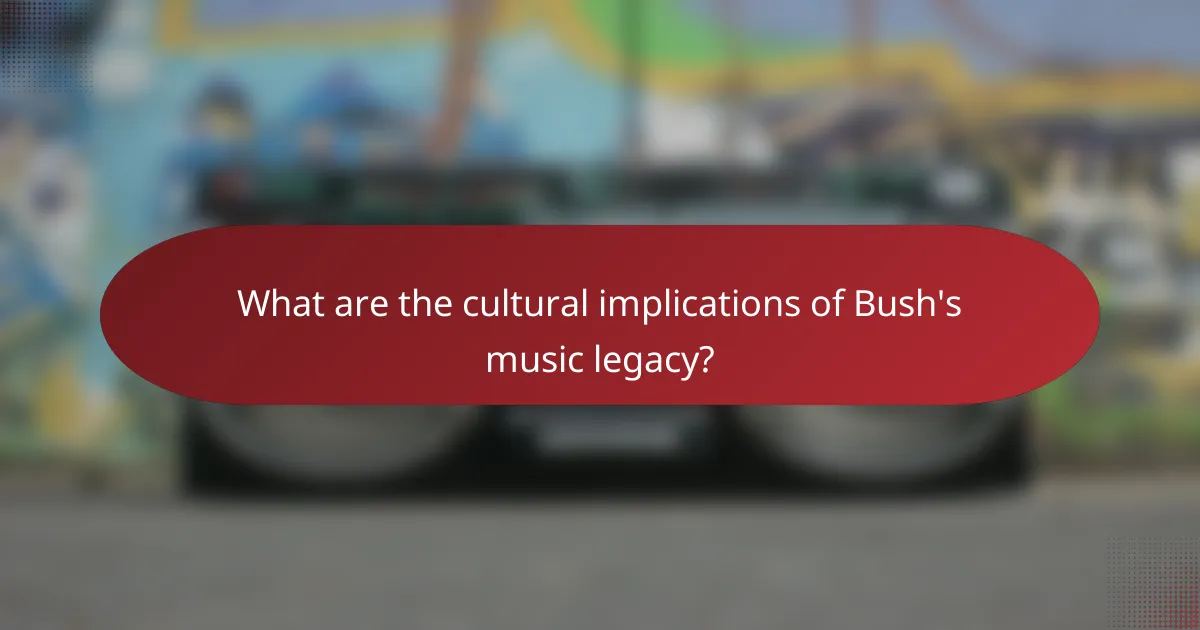
What are the cultural implications of Bush’s music legacy?
George W. Bush’s music legacy reflects a blend of personal taste and broader cultural trends, influencing American society in various ways. His musical preferences, including country and classic rock, resonate with a significant portion of the American populace, shaping perceptions of leadership and identity.
Influence on subsequent presidents
Bush’s music choices have set a precedent for how future presidents engage with popular culture. For instance, Barack Obama embraced a diverse playlist that included hip-hop and R&B, reflecting a shift towards inclusivity in presidential music preferences. This evolution highlights how music can serve as a tool for connection and relatability in political leadership.
Moreover, Donald Trump’s use of classic rock and pop songs at rallies indicates a continuation of the trend where presidents utilize music to energize their base. This pattern shows that music remains a vital part of political identity and communication strategies.
Shaping of American identity
Bush’s music legacy contributes to the shaping of American identity by reinforcing cultural values associated with patriotism and tradition. His affinity for country music, often linked to themes of family and community, resonates with many Americans, promoting a sense of shared values and experiences.
Additionally, the music played during his presidency often reflected the national mood during significant events, such as post-9/11 resilience. This connection between music and national identity illustrates how leaders can influence cultural narratives through their musical preferences, impacting how citizens perceive their own identity in relation to the nation.
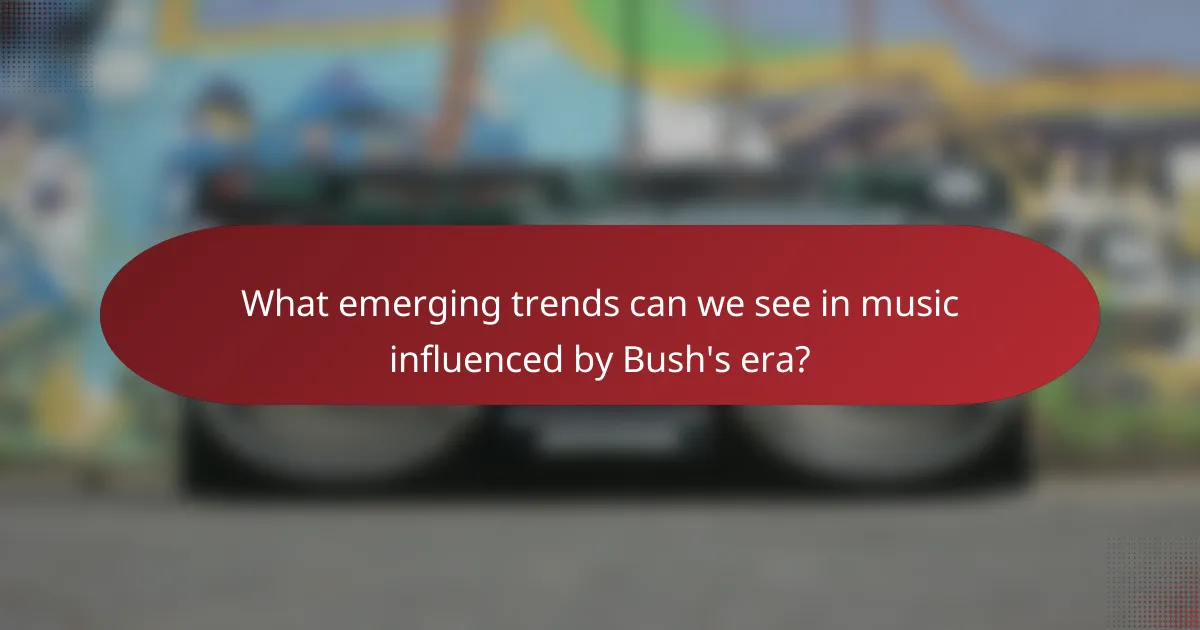
What emerging trends can we see in music influenced by Bush’s era?
The music influenced by George W. Bush’s presidency reflects a blend of political commentary, social awareness, and evolving genres. Artists during this time often used their platforms to address issues such as war, economic disparity, and civil rights, leading to a resurgence of politically charged music across various styles.
Political Themes in Lyrics
During Bush’s presidency, many musicians incorporated political themes into their lyrics, responding to events like the Iraq War and domestic policies. This trend saw genres like punk, hip-hop, and folk music become more vocal about social justice and anti-war sentiments. Artists such as Green Day and Eminem exemplified this shift, using their music to challenge the status quo.
Rise of Independent Artists
The early 2000s marked a significant rise in independent artists who often rejected mainstream music industry norms. Fueled by the internet and social media, these musicians found new ways to distribute their work and connect with audiences. This democratization of music allowed diverse voices to emerge, reflecting a broader spectrum of American culture.
Fusion of Genres
Bush’s era also saw a notable fusion of genres, as artists blended elements from rock, hip-hop, and electronic music to create innovative sounds. This experimentation led to the emergence of new subgenres, such as emo-rap and folk-punk, which resonated with younger audiences seeking authenticity and relatability in their music.
Impact on Live Performances
Live performances during this time became platforms for political expression, with artists often incorporating visual elements that highlighted social issues. Concerts turned into rallies, where musicians encouraged fans to engage in activism. This trend not only amplified the messages in their music but also fostered a sense of community among concertgoers.
